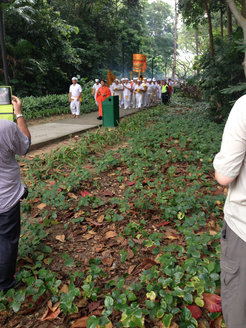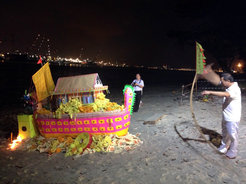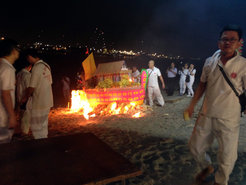Religious Diversity in Singapore
by Peter van der Veer
Singapore today is a product of inimitable urban planning and social engineering. What has been achieved under the one-party dominance of the PAP (People’s Action Party) under the leadership of Prime Minister Lee Kuan-Yew and his son is in many ways admirable. Since its formation in 1963 Singapore has developed into one of the ten richest countries in the world. It has been spared much of the social unrest that besets its neighbors, Indonesia, Malaysia, and Thailand. Through a well-conceived master plan, public housing has been distributed on an ethnic-quota basis that has prevented ghetto formation. Since the 1960s, the entire urban space has been reorganized by destroying the old kampongs and placing people in the new Housing Development Blocks. The social engineering of multiculturalism and ethnic harmony by disturbing the old ethnic solidarities through spatial distribution is remarkable. It has only been possible through enlightened authoritarian rule, strict labor immigration rules with little possibility of acquiring citizenship for migrant workers, and a dominance of one ethnic group, the Chinese, vis-à-vis substantial other groups, Malay, and Indian in a relatively small urban population. What is sometimes called the Singapore Model has inspired politicians in India and China, but it is a model that cannot be followed anywhere else, and certainly not in huge nation-states, like India.
What brought me to Singapore is a project on Chinese Temple Networks in S.E. Asia that Kenneth Dean (currently James McGill Professor of Chinese Studies at McGill in Montreal and from January 2015 Professor and Head of Chinese Studies at the National University of Singapore) and I have started. Dean has worked since the 1980s in Fujian (South China) and has over the last five years collected material (ethnographic and historical) on the movement of temples in Singapore and on their connections with temples in Fujian. A large book of 1400 pages is being prepared for publication by NUS Press. For me, there are two striking observations emerging out of this work. One is the secular planning of religion in Singapore.
Since temples only can get a lease of the land from the government for thirty years they have to raise enormous amounts of money to be able to stay where they are or otherwise they have to move to cheaper locations at the margins of the city. An alternative is to combine temples of different communities in one space that is leased by unified efforts.

Secondly, Dean has evidence that temples in Fujianese hometowns of Singaporean Chinese are being rebuilt and ritual networks re-established after the secularist onslaught of the 1950s and 1960s in Communist China. This means that at the time that Singapore itself was officially secularized by urban planning religious organizations, movements, and institutions developed ritual activities and spaces in South China. The ways in which spatial arrangements are configured through secular interventions and religious creativity has to be studied and conceptualized further in order to be able to make a significant contribution to our general understanding of nation-states, ritual, and religious organization. Secularization by real estate pricing in Singapore and outright secular destruction in Communist China are coupled with the resilience of temple communities in Singapore and their role in rebuilding and revitalizing in South China. This puts the general sinological emphasis on Beijing and the centralizing empire into question. It seems that repeatedly it is Nanyang that is the significant context for what happens in South China. If that is the case, we may find that at various levels, economic (business, trade, labor) and cultural (religion, architecture, the arts).

During the last few weeks, Kenneth Dean and our local Max Planck research fellow Dr Hue Guan Thye, have brought me to a number of unity temples in Singapore, in which one finds a Chinese Daoist temple side by side with a Hindu temple and a Muslim shrine; all for reasons of raising funds for leasing the land. They also brought me to spaces in the industrial areas of Singapore in which one finds whole stretches of different community temples, whose communities are spread over the city.
The most spectacular thing we saw, however, was the nine emperor festival九皇爺; Jiǔhuángyé. There is a good description on the government website ![]() http://eresources.nlb.gov.sg/infopedia/articles/SIP_1849_2011-10-21.html (accessed 17.10.2014):
http://eresources.nlb.gov.sg/infopedia/articles/SIP_1849_2011-10-21.html (accessed 17.10.2014):
“The Nine Emperor Gods Festival” is held from the first to the ninth day of the ninth lunar month among Chinese communities in Southeast Asia. It begins with the welcoming of the gods into the temple where they are to be worshipped for nine days, and ends when the gods are sent off on the ninth day. The festival is known for the temple processions that take place during the celebrations. The oldest Nine Emperor Gods temple in Singapore is the Hougang Tou Mu Temple at 779A Upper Serangoon Road.
The identity of the Nine Emperor Gods is shrouded in mystery and worshippers revere an urn that represents their deities. In Taoist scriptures, it was recorded that they were the sons of Doumu. After gaining enlightenment, Doumu imparted her transcendental knowledge to her nine sons. Her sons became the star deities known as Beidou Jiuxing, which are known in the western constellations as the Northern Dipper. Doumu, as the mother of the Northern Dipper, is known as the Doumu tianzun, meaning “Heaven-honoured Bushel Mother”. She and her husband control the pivot of the North Pole, around which the nine stars revolve under surveillance by her sons. In Taoist beliefs, the Northern Dipper controls the fate of individuals and the welfare of the state. The northern direction is also associated with the water element, the symbol of life and death, and Doumu is known as a merciful water spirit who offers protection for seafarers.
In Folk Taoism, the origins of the Nine Emperor Gods are mixed with local folklore. The book Xinjiapo xungen states that the Nine Emperor Gods were personified as Lu Wang, the ninth prince of the Ming Dynasty. He was worshipped in honour of his efforts to overthrow the Qing Dynasty. According to an oral version in Singapore, the festival is held in remembrance of a tragic flooding incident in Fujian in which the gods appeared beforehand to warn people of impending disaster.
We started at the Hougang Toumu Temple on Serangoon Road, mentioned above as the first nine emperors temple in Singapore, but found that the procession had already moved from the temple to another site, namely an inner courtyard with a basketball court in a Housing Development Block, where the temple had been removed because of the above mentioned governmental planning, but a few makeshift shrines existed, plus a couple of apartments that had been converted into temples. The community waited for the trucks that carried the palanquin with the urn containing the deities. The men carrying the palanquin swayed back and forth to indicate the power of the deity inside the urn. They were awaited by a man with a whip who controlled the spirits, and by a large group of devotees clad in white who sounded drums. Finally there were a couple of dragon dances. The group from the Hougang Toumu Temple paid their respect to the shrines in the basketball court and after an hour or so moved further to the next location. All in all a jolly affair.

On the last day of the festival we went first to a neighborhood with a still existing temple of the Teochew community.
The original neighborhood community had spread over the city and into Malaysia, but for this occasion many came back to the temple, showing a lasting solidarity despite spatial dislocation. There were mediums who became possessed by the emperor-gods and after a number of activities, in which some members of the community were allowed to play a prominent role based on their large financial contribution, everyone went in buses and trucks to the seaside to perform the farewell ceremony that entailed a reciting of names by a Taoist priest and the burning of ritual paper and incense josh sticks, ending the sending off of the urn in a boat.

In the evening of the same day we went to another neighborhood where a huge buffet was prepared for the devotees, who afterwards flocked into a temple with nine palanquins containing the gods as well as a palanquin carrying Doumu. There were nine mediums possessed by the brother-gods who all went with the palanquins, a spectacular happening with a lot of drum beating.


Very remarkable was that the road next to the temple was on a public bus-line and that everyone, mediums include, would just stop and wait till the bus had passed. After a circumambulation by the palanquins of the temple, everyone went on buses and trucks to perform the farewell ceremony at the seaside.
Here the remarkable aspect was that after the rituals had been performed, everyone, except for the inner circle of devotees and organizers, left to go back without much ado, leaving the burning of a nice paper boat and the caring of the images of the deities to the happy few. The sudden departure into secular space after all this preparation and hectic performance came as a surprise to me and is in need of further clarification.

The origins of the festival may have been in China, although this is not clear, but the development of it over the last century has been in S.E. Asia. What I find remarkable is that it coincides with another festival of nine planets, namely Navaratri, an important Hindu festival. That coincidence and the fact that the Chinese devotees of the Nine Emperors have to eat vegetarian during the nine days of celebration makes one wonder about the ritual interactions that took place in S.E. Asia, between the Chinese and Indians. It would be obviously no surprise if all kinds of syncretism took place in the context of the encounters of Indians, Malay, and Chinese. Considering scholarly interest in processes of creolisation, syncretism, and interaction, this is an aspect of the ritual that is in need of further exploration.


















